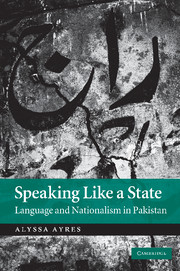Book contents
- Frontmatter
- Contents
- List of illustrations
- List of tables
- Acknowledgments
- Note on transliteration
- Introduction
- 1 Articulating a new nation
- 2 Urdu and the nation
- 3 The nation and its margins
- 4 The case of Punjab, part I: elite efforts
- 5 The case of Punjab, part II: popular culture
- 6 History and local absence
- 7 Bringing back the local past
- 8 Speaking like a state: language planning
- 9 Religion, nation, language
- 10 Conclusion
- Bibliography
- Index
8 - Speaking like a state: language planning
Published online by Cambridge University Press: 25 August 2009
- Frontmatter
- Contents
- List of illustrations
- List of tables
- Acknowledgments
- Note on transliteration
- Introduction
- 1 Articulating a new nation
- 2 Urdu and the nation
- 3 The nation and its margins
- 4 The case of Punjab, part I: elite efforts
- 5 The case of Punjab, part II: popular culture
- 6 History and local absence
- 7 Bringing back the local past
- 8 Speaking like a state: language planning
- 9 Religion, nation, language
- 10 Conclusion
- Bibliography
- Index
Summary
When the United Nations was established in 1945, 750 million people – almost a third of the world's population – lived in territories that were non-self-governing, dependent on colonial powers. Today, fewer than 2 million people live in such territories.
United Nations, “The United Nations and Decolonization”From its founding in 1945 through today, the number of “member states” of the United Nations ballooned from the original fifty-one to its current membership of 192 states. This one measure illustrates the dramatic reshaping of the world's political geography, ushering out the era of empire and inaugurating a true globalization of the nation-form in just fifty-some years. The new nation-states each declared new national languages and undertook new programs of language modernization and development to effect their national usage. If the age of empire, as Bernard Cohn astutely reminded us, required the command of language and the language of command to effect dominance of a very few over the very many, a different understanding of the relationship between language and polity emerged from the decolonization wave – namely, the necessity of an entire population sharing a national language in order to demonstrate national unity. Doubtless, the age of empire produced certain types of official languages: in British India and the Dutch East Indies, for example, Hindustani and brabbel-Maleisch were clearly products of the colonial encounter, languages which accommodated a certain kind of transregional communication, nearly entirely urban, not entirely possible through Bengali, Tamil, or Javanese.
- Type
- Chapter
- Information
- Speaking Like a StateLanguage and Nationalism in Pakistan, pp. 150 - 170Publisher: Cambridge University PressPrint publication year: 2009



